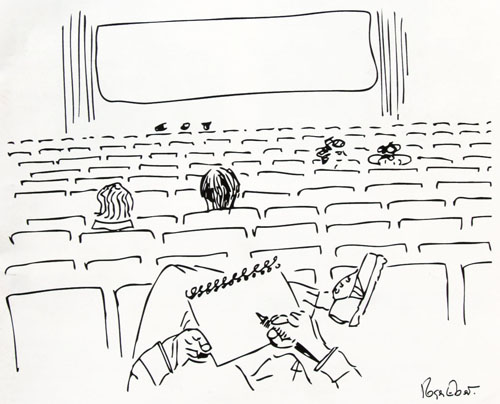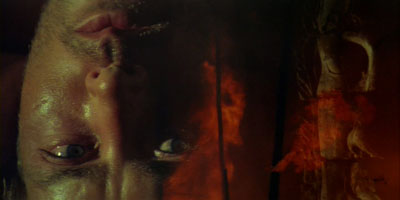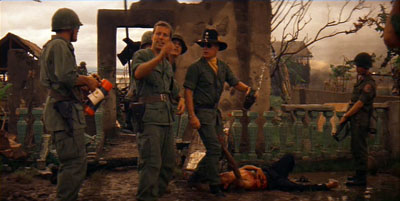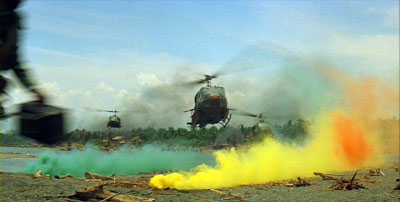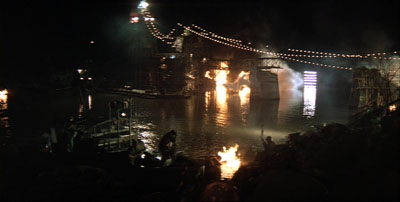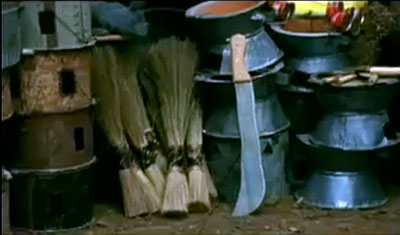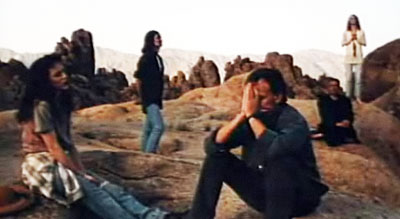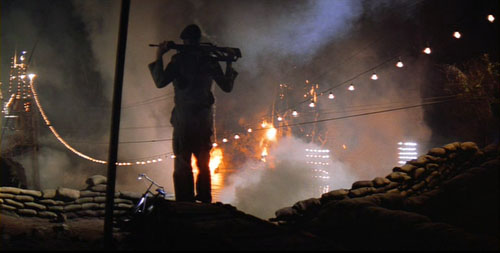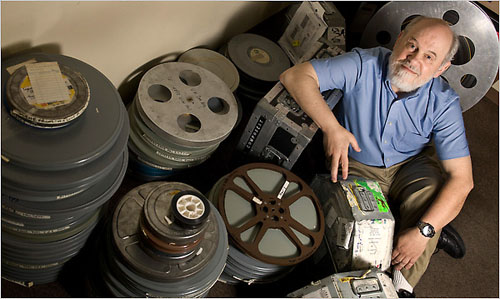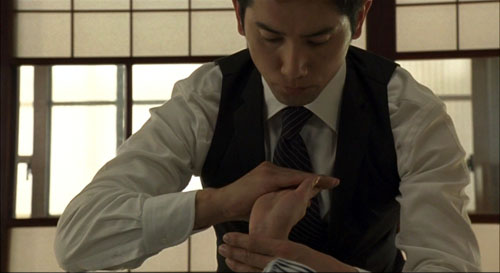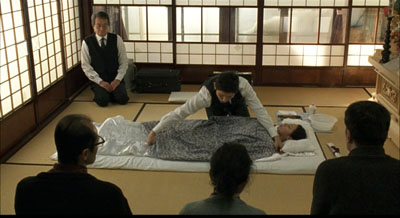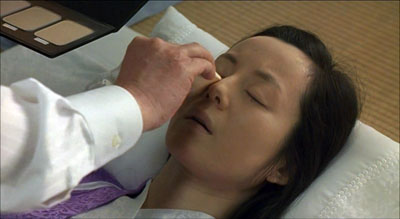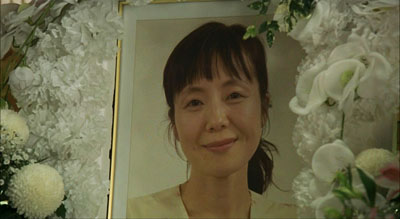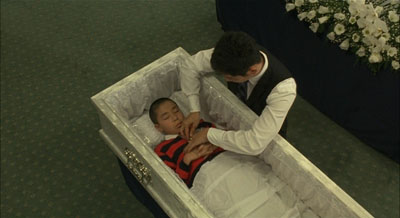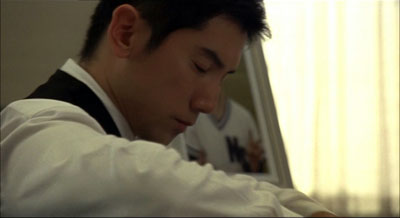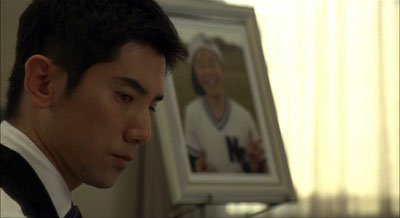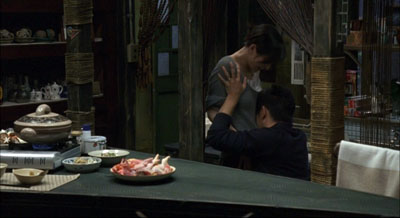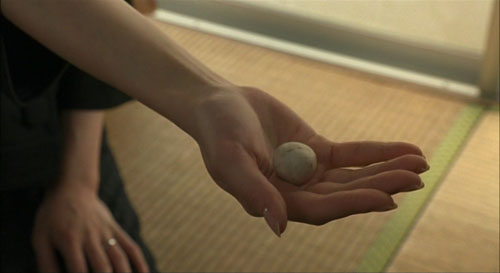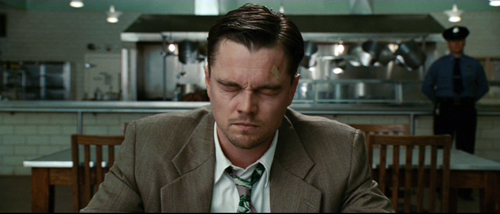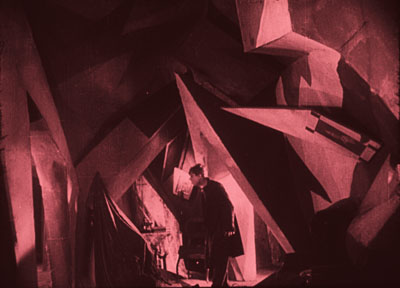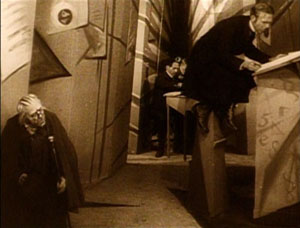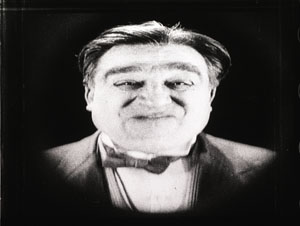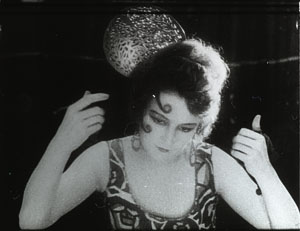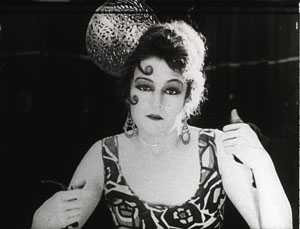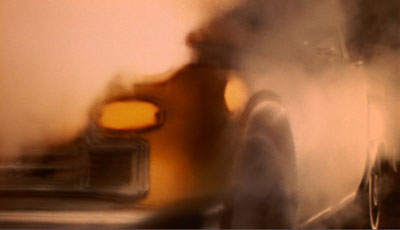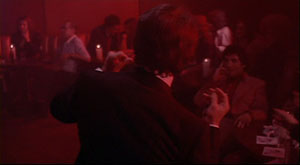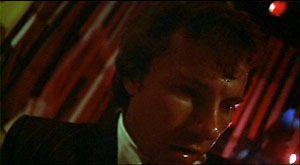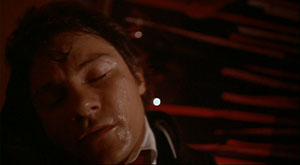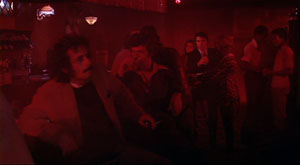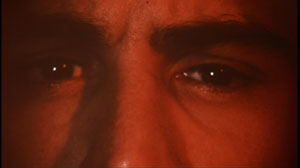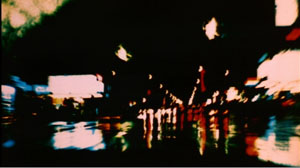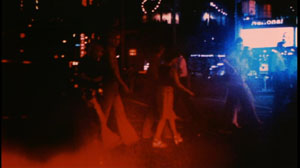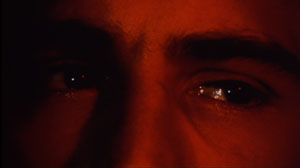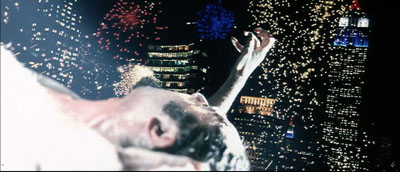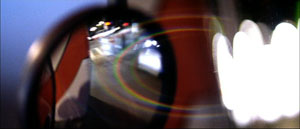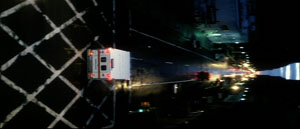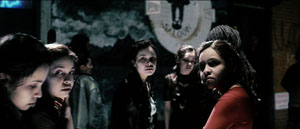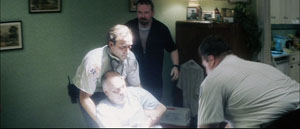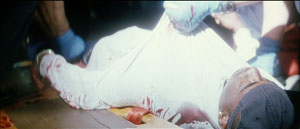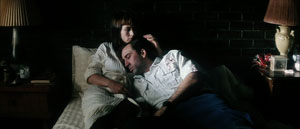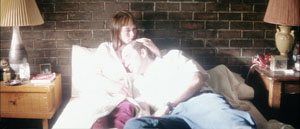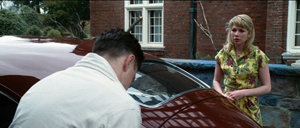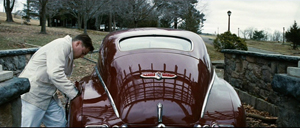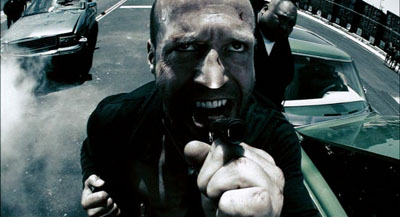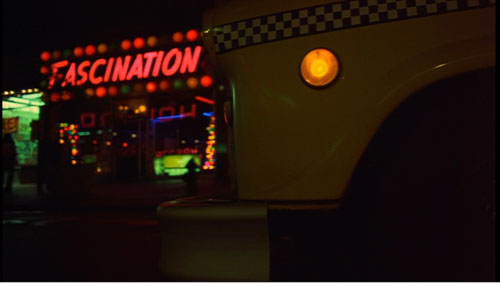Archive for April 2010
Festival as repertory
DB here:
This picture points backward and forward. It looks back to the days when movies were shown on a big screen to hundreds of people in real time. No pausing or fast forwarding; you take what you get. Some viewers are settled in pretty close to the screen, and a few dare to sit in the front row. (Save me the center seat, fortunately still vacant.) The critic sits slumped far back, implying coolly distant appraisal. The pen is poised to note down moments of power, beauty, or stupidity.
But the big auditorium is nearly empty, and this makes the drawing foreshadow the approaching end of moviegoing. The warning signs are emerging: Visit any movie, even an Imax spectacular, in the off-hours (Monday through Wednesday, especially matinees) and you’re likely to find the house as empty as it is here. As for the critic, ready to jot down notes for a review: An anachronism these days, as many will tell you.
But wait. Isn’t the theatrical business booming? We’re told that 2009 was a banner year, and 2010 will be even better. True, worldwide admissions for 2009 totaled $29.9 billion, a new high. But the increase, according to the MPAA, is mostly due to 3D. In the US, the format accounted for 11 % of the country’s $10.6 billion box-office income, a sum about equal to the gain over last year’s take. Moreover, the number of domestic tickets sold increased only a little from recent years, to 1.4 billion. Overall, the years 2005-2009 have fallen off from the high points of 2002-2004, when attendance was 1.5 billion or more.
Nor is the international film industry expanding its audience. For the last five years or so, worldwide attendance has been remarkably flat, with only the Asia-Pacific region seeing signs of growth. Overall, it seems, 3D serves to let Hollywood hang on to its audience, and charge more.
The spurt in theatrical income helps offset the decline of packaged media. The DVD sell-through boom lasted from 1998 to about 2008, when subscription rental companies (Netflix, Lovefilm) and kiosks (Redbox et al) pushed down retail sales. The slump was accelerated by a glut of DVD releases, big-box stores offering discs at rock-bottom prices, the rise of downloading and video on demand, and, not least, a massive recession that made consumers cost-conscious. Today, many industry observers think that young people are more inclined to graze in the luxuriance of YouTube than visit the multiplex. At best, the Millennials might watch a current hit streaming on their cellphones or laptops or TV monitor. An admittedly small-scale inquiry in the recent Screen Digest (April, p. 100; here, but proprietary) suggests that most young entertainment fans don’t feel a need to rent a disc, let alone buy one. Moreover, all those sampled saw far more movies on monitors, often through shady downloads, than on theatre screens.
It’s not hard to imagine a near future when a movie opens simultaneously on the global market to satisfy its most devoted public before moving in a very few weeks to DVD, VOD, iTunes, and other digital platforms. It then snuggles into hundreds of thousands of hard drives around the world, ready to be awakened when somebody feels the urge to watch. These seem to be the two poles we’re moving toward: the brief big-screen shotgun blast, and the limbo of everlasting virtual access. You can argue that the very success of home video, cable, and the internet have cheapened our sense of a movie’s identity.
Which is one reason why film festivals are very, very important.
Apocalypse then and now
I’ve spent most of the last several weeks at festivals. The Hong Kong International Film Festival is a 2 1/2 week showcase of global cinema, attached to a major regional market assembly and spiced with local attractions and international retrospectives. The Wisconsin Film Festival is a 4 1/2 day local event highlighting US independent cinema but with a leavening of recent arthouse titles and restored classics. Ebertfest, formerly Roger Ebert’s Festival of Overlooked Films, is a topical festival held in a single venue, featuring a wide array of guests, and reflecting its founder’s eclectic tastes.
Each offers unique pleasures, and each reaffirms the value of the theatrical motion-picture experience. I’ve already written a bit about Hong Kong here and here and here, and I hope to write more about the Wisconsin event soon. For now I’ll concentrate on a few high points of Ebertfest, which took Roger’s cartoon above as its emblem. Kristin and I have been guests for many years (our posts are in the Festivals: Ebertfest category on the right), but this time she was in Egypt scouring the sands for pieces of statues. So I’ve had to blog solo.
Fortunately, we now have a vast archive of what happened in Urbana. With the generosity typical of Roger’s event, all the Q & A sessions and panel discussions were recorded and streamed. They’re available here. And for an appreciative account of what it all means, see Jim Emerson’s piece on Roger’s site.
Start with the obvious. Apocalypse Now Redux was shown in a Technicolor restoration in the Virginia Theatre, a picture palace built in 1926. The image loomed, the sound engulfed you. Several people, most of them young, told me that they felt privileged to have seen the film, for once in their lives, as it must be seen. As soon as you get a home theatre that matches this presentation in sheer primal impact, call me. I’m coming over.
Editor and sound designer Walter Murch, one of my heroes, was prevented from coming by the European volcano ash. So I tried in my introduction to pay homage to what is surely one of the most complex soundtracks of any film of the period—a mixture of synthesizer, rock and roll, and layer upon layer of subtly enhanced noises. During the screening I was able to appreciate some of the daring soundfields Murch created. When Willard gets up to look out the blinds of his Saigon hotel, the sound in the left and right and surround channels narrows abruptly to the central speaker, bringing him back to mundane R & R reality. Later, most ordinary dialogue comes from the central speaker, but when Willard voices his commentary, we hear him from all three front speakers; the soft tone creates an intimacy, while the auditory spread gives it weight and authority.
A panel of commentators including Ali Arikan, Michael Phillips, and Janet Pierson did a fine job of probing various aspects of the film. Ali considers it Coppola’s crowning achievement and one of the great American films. Michael, by contrast, thought that what he aptly called the “terror and grandeur” of its opening half gives way to off-kilter and pretentious scenes in Kurtz’s compound. Janet, who had seen the film on the big screen more often than any of us, found it an enduringly impressive accomplishment in both sound and image. With the audience we had a lively exchange about the role of women in the film and the inclusion of the notorious French plantation sequence. Matt Zoller Seitz made a shrewd point about how the film shows Americans bringing along homegrown entertainments (Playmate performances, rock music, surfing) to redefine the war in familiar terms.
Despite all the shock and awe, I like the film only moderately. It’s a stunning logistical accomplishment, and it has some brilliant moments; but I think it has problems almost as soon as Willard moves upriver. I might be the only person who finds the Kilgore scenes overdrawn, almost Dr. Strangeloveish. When Kurtz bends down to give water to the wounded Vietnamese, he’s interrupted by news of surfing, and he yanks his canteen away as the VC scrabbles for it.
Heavy, heavy—as is the repeated motif of Americans strafing civilians and then tending to their wounds. Willard spells it out: “We cut them in half and then give them a Band-Aid.” Yet I still admire the utterly disorienting opening, which mixes thrumming choppers with ceiling fans and justifies what Michael Herr called it: the rock-and-roll war. Later we’ll see battles wreathed in psychedelic haze, and a hallucinatory assault on the bridge, with Willard stumbling through the dark and watching battle-fried infantrymen hurl ordnance into a void. It’s like a light show at the climax of a rock concert.
One of my favorite comments about the movie came during Dick Cavett’s television show circa 1980. Dick asked Jean-Luc Godard what he thought of Apocalypse Now. This was a period in which most of the press coverage obsessed about the film’s soaring budget. Godard remarked that Coppola had not spent enough. Cavett asked for an explanation. Godard: “Well, he spent only fifty million dollars and the war cost fifty billion. You cannot film this war on such a small budget.” That’s the way I remember it, anyhow.
From Rwanda to LA
Quick notes on two other E’fest titles. (I’ve already discussed Departures here.)
“I wanted to make a film for a Rwandan audience.” Not what you might expect to hear from an American director of Korean descent. Accordingly, Lee Isaac Chung gave Munyurangabo a leisurely pace and structure. The plot centers on two young men, Sangwa and Munyurangabo (aka Ngabo), taking what seems to be an enigmatic journey. One is Hutu, the other Tutsi. Longish takes and fairly distant framings follow them hitchhiking and stopping over at Sangwa’s home. Gradually, hints such as Ngabo’s carefully wrapped machete suggest that they are heading toward a confrontation. When the revelation comes, our attachment shifts from Sangwa and his family conflicts to Ngabo’s mission of vengeance. Chung explained that the soundtrack develops accordingly, moving from objectivity to subjectivity as we start to hear what his two protagonists hear.
The production background, explained by Chung and his colleagues Sam Anderson (co-writer and producer) and Jenny Lund (co-producer and sound recordist), was fascinating. The script consisted largely of a scene outline, and the dialogue was developed with the actors. The Americans worked with translators in guiding the performances. In some cases they drew on their own experiences. Perhaps partly because of its respect for everyday life, the film has been shown on local television and in the Parliament. It has become a Rwandan film.
My colleague J. J. Murphy has written an acute analysis of Munyurangabo. He rightly praises the sudden entrance of a bardic young man who recites a six-minute poem celebrating liberation and reconciliation. The performance wasn’t planned, Chung said, but it has become a high point of the film. J. J. also links to other enlightening interviews given by Chung, Anderson, and Lund.
If Munyurangabo’s loose structure evokes the Dardennes brothers, Michael Tolkin’s The New Age has the coiled-serpent dramaturgy of a classic psychodrama-comedy. It’s 1994, and a prosperous LA couple is suddenly without income. Facing bankruptcy, Katherine and Peter auction off their paintings, try to borrow from Peter’s father, and eventually open a boutique catering to the tastes of their friends. At the same time they slide into casual affairs and ceremonies of New Age spirituality. Ebert’s review captures the movie’s range of reference:
Tolkin gives us one richly detailed set piece after another, involving luncheons, openings, massages, telephone tag, psychic consultations, sex, heartfelt conversation, and pagan rituals led by a bald-headed woman who sees what others cannot see. Meanwhile, the material universe remains the one thing Peter and Katherine can really count on.
Few American films examine money and class, but this one is actually about needing a paycheck. By the end, when each of our protagonists becomes a seller rather than a buyer, we have seen a remarkably sharp dissection of a lifestyle.
In the Q & A afterward, Tolkin said that the genesis of the film came from watching a Melrose shop sink into failure. When I saw the film on its initial release, lines like “It’s not an insult, it’s an intervention” and “We need space” (psychological, but also retail) leaned me toward taking the film as satire. I still do. But Tolkin insists that it’s not. The plot dares to have two truly repellant protagonists, but Tolkin doesn’t find them nasty. “I like them.” He majored in religion in college and he takes his characters’ beliefs, no matter how shallow, seriously—not a big surprise from the creator of The Rapture.
He elaborated on some differences between novels and films. When he rereads one of his novels, he thinks, “How was I ever that smart?” but when he rewatches a film it’s the imperfections that jump out. A movie has to be more compressed and rhythmically varied than a novel—something The New Age demonstrates in its brisk montages alternating with slowly unfolding scenes. In the discussion Jim Emerson praised the film’s density of detail, Tolkin elaborated by invoking William Carlos Williams’ belief in compact expression.
The next two paragraphs include plot details you may prefer to pass over.
Tolkin’s script is indeed firmly contoured. The couple’s crucial quarrel takes place at the thirty-minute mark and launches the two major plot lines. They decide to try a separation (while sharing the house), and they launch their boutique. The development section begins about halfway through, as they conduct their love affairs and watch the shop founder. The last act presents their options: bankruptcy, suicide, low-end work.
Arguably the climax is Peter’s desperate effort to make his first telemarketing sale. Here, I think, Tolkin’s ambivalent sympathies come out. Early in the film Peter had asked a cold-caller whether he ever thought he’d be doing this as a career; it’s less a moral condemnation than glib snobbery. But when Peter has to close the sale, his self-loathing is mixed with a certain pride. The cashiered ad exec finds that he can do this. He’s on the road back.
The gorgeously designed movie, with hard blacks and saturated primaries, has a developing palette (“swatches for each act,” Tolkin says). Unhappily, I can’t study the design arc here because The New Age seems never to have had a DVD release. So much for the Celestial Multiplex. Good old 35mm pulled us through, in a radiant print.
Scholars seem now to agree that film festivals serve as an alternative international distribution system. Like Hollywood’s more formal and routinized machine, festivals bring movies to audiences. Usually the movies are current ones, and a festival is offering local viewers their only chance to see such pictures before video release.
Ebertfest shows that there’s an essential place for what we might call the repertory festival. That’s one that revives and reappraises films from earlier periods—and “earlier” may mean only a few years ago. Jumping from 1929 (Man with a Movie Camera, accompanied by the Alloy Orchestra) to the 1980s (Apocalypse Now, Barfly) and the 1990s (The New Age) and then right up to 2008 (Vincent, Trucker, Departures, Synecdoche, New York, Song Sung Blue), this year’s edition reminds us that every film, old or new, is a part of history.
To come fully into history, I’m convinced, a film needs scale. Even intimate dramas attain their true gravity when spread out like a gigantic picnic on a pale blanket. It’s not the only way to enjoy cinema, certainly; but it’s one that we must never abandon. Like the note-taker in the back row and the geeks up front, everyone needs a full view.
Apocalypse Now Redux.
PS 28 April: I just discovered this piece by Steven Zeitchik, who argues that reviving classics in a big-screen event format could also be good business.
All the prints that fit the news
Blowing Your Own Horn Dept: The New York Times has an article about this blog and our academic work here. Thanks to Manohla Dargis for her kind remarks.
Notice: No films were harmed in the making of this picture.
A second chance at childhood
DB here:
This year Ebertfest has been such a swirl of activity that I hardly know where to start. Jim Emerson’s reportage, here and here, decorated with neat photos and trim Tweets, has admirably hit the high points—the panels, the Q & A’s, and the young Web critics, or “foreign correspondents,” that Roger has summoned to his annual get-together. There’s even streaming of the panels and Q & A.
After participating in four events in rapid succession, I find that I’m still sorting out impressions. I hope to do justice to the broad swathe of doings in another entry after I get home tomorrow. For now, why not just let my impulses take over and write about my most enjoyable movie so far?
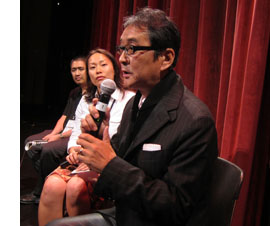 Takita Yojiro’s Departures (2008) well deserves the standing ovation that greeted him when he stepped out on the Virginia Theatre stage. I mentioned the film last year, and since then I’ve seen it two more times, not counting the splendid projection Friday. I was happy that Roger shares my affection for the movie. In my remarks before the screening, I praised the movie’s willingness to go straight for the heart. This sort of sincerity, which John Ford or Frank Borzage would have understood, is hard to come by in today’s American cinema, where emotion tends to be framed by irony or self-consciousness cuteness (500 Days of Summer). My intro did mention the comedy in the film, but I didn’t stress it enough. Watching it with the Ebertfest audience again taught me that the film cleverly uses humor to lead us into its pathos.
Takita Yojiro’s Departures (2008) well deserves the standing ovation that greeted him when he stepped out on the Virginia Theatre stage. I mentioned the film last year, and since then I’ve seen it two more times, not counting the splendid projection Friday. I was happy that Roger shares my affection for the movie. In my remarks before the screening, I praised the movie’s willingness to go straight for the heart. This sort of sincerity, which John Ford or Frank Borzage would have understood, is hard to come by in today’s American cinema, where emotion tends to be framed by irony or self-consciousness cuteness (500 Days of Summer). My intro did mention the comedy in the film, but I didn’t stress it enough. Watching it with the Ebertfest audience again taught me that the film cleverly uses humor to lead us into its pathos.
The first half hour handles a lot of narrative business. We need to meet the main characters and learn their situation, of course. We also need an introduction to the trade of encoffinment, the practice of preparing the body of the deceased for cremation. But if the story proceeded chronologically, we wouldn’t get this introductory scene for quite a while. So the film provides a pre-credits flashforward that serves up the process, making it palatable with a dose of humor.
We see Daigo and his crusty boss Sasaki visiting a household and arranging a young woman’s corpse. No, it’s not a woman: Daigo discovers that the corpse has a penis. Should they apply male or female make-up? This bit of comedy undercuts the solemnity of the occasion and builds up curiosity: How to resolve the situation? Cut back to Daigo two months earlier, playing the cello in an orchestra that is about to be disbanded. The end of his musical career sends him and his wife back to his hometown seeking a new job.
Since the first scene shows Daigo practicing the “sending-off” trade, we know how that search will turn out. With our superior knowledge we can enjoy all the misunderstandings that fill the first scenes in Yamagata. A misprint in the newspaper ad makes Daigo think he’s applying to a travel bureau; Sasaki hires him without glancing at his résumé; Daigo becomes disturbed at the prospect of handling dead bodies, but the generous advance makes him decide to try. Moreover, in the opening we’ve watched him skillfully executing the routines of the ceremony, so we know that he will eventually succeed. The question is how.
One of the pleasures of movies is showing us how people work. (Think of Steve McQueen running the ship’s engine in The Sand Pebbles, or the arcana of sleight of hand in The Prestige.) So the opening fascinates by introducing us, matter-of-factly, to a craft. In doing so, the scene treats the ceremony fairly objectively. A second ceremony is staged for a video demo, with Daigo serving as the corpse. Here the comedy is even broader, but we’re still learning about the procedures.
A third ceremony, involving the decomposed body of an old woman, is skipped over, but it is heavy in consequences. It drives Daigo to the bathhouse to clean up, and there he reunites with an old friend and his mother, the bathhouse owner. The third encounter also makes Daigo return to playing the cello, using the instrument he was given as a boy. In a way, the whole story offers another chance at childhood. Daigo, feeling guilty for abandoning his mother and angry at the father who deserted them, will be granted a chance to reconcile with both.
The film’s next sending-off ceremony is a turning point, for it’s Daigo’s first encounter with the dignity of Sasaki’s craft. With the young man we study the tender precision with which Sasaki tucks the dead wife’s garments around her, strokes her face and hands, and applies her favorite lipstick. The husband, initially enraged that Sasaki and Daigo arrived late, ends up moved to tears: “She never looked so beautiful.” Here, fifty minutes into the film, humor is suspended in order to present a compassionate gravity in the face of death. Characteristically, however, a certain lightness returns when in the car Sasaki and Daigo chew noisily on the snacks the husband has given them.
From a penis joke and Daigo’s humiliation at playing dead for the video, the film has led us to care about the characters. We can relax and start to appreciate the depths of what Sasaki and Daigo do. The film will busy itself with new problems—the shame Daigo faces in pursuing this craft, his stratagems for concealing it from his wife Mika, his revived memories of his father, a subplot involving another son impatient with his mother—but we are now ready for these enrichments of the central situation. Eventually too we will see the encoffinment ceremony though other characters’ eyes, as they arrive at our appreciation of its astringent tenderness.
The shrewd placement of the opening flashforward has gently pulled us into the story’s world and its key issue, the tie between the living and the dead. By the time that we return to that family and their transvestite son, the question of how to make up his face has gathered a thick array of associations. The parents’ quarrel anticipates all the other parent/ child relationships that accrue across the film, and the resolution of it, through a father acknowledging his guilt, provides a foretaste of the climax.
The unruffled exactness of Sasaki’s tradecraft is mirrored in Takita’s direction. This is classic Japanese filmmaking: Not a wasted shot, each angle precisely depicting what we need to see at any moment. After the fumbling and flailing displayed by most contemporary Hollywood directors, after filmmakers’ urge to “give a scene energy” manages to muff getting an actor out of a car, it’s a pleasure to watch powerful effects achieved delicately. How many movies can wring tears from uncurling a fist or an image of a smooth stone on a woman’s palm?
Several scenes of the dead include photos of the person in life. Early on, these are given force through simple cutaways.
Once he’s trained us to watch for these photos, Takita can let us compare death and life through more discreet revelations, as when a slight movement of Daigo’s head allows us to see a photo that remains out of focus.
Or take the moment when Daigo comes home after preparing the decomposed body. He gags when he sees that Mika is preparing raw chopped chicken, but then he frantically embraces her. The gestures begin in panic but end in desire. At this point Takita cuts to a new angle, a long shot showing the couple, the table, and the dish that triggered it all.
It’s always sound practice to tactfully recall earlier moments in a film, but the composition also completes the scene’s arc from disgust at death to ardent vitality.
The whole film’s craftsmanship is as warm and fastidious as the job practiced by the send-off experts. At the end, Daigo’s respectful handiwork, with all its dispassionate concern, turns into caresses, the intimate gestures of a son rediscovering a parent through physical contact. Modulation of movement, mood, and attitude; slight variations that become subtly expressive; the prosaic detail that cuts right through you: In this domain the Japanese cinema has no superior. Departures shows that this tradition lives on.
Scorsese, ‘pressionist
Shutter Island.
I was interested in the way she presented herself at that moment. Later on I figured out that as she gets up from the chair we should do it in three cuts, three separate close-ups, because I think he’ll never forget that moment the rest of his life. He’ll play it back many times. . . . It’s just his perception, his memory of what it’s going to be like. . . . We shot it very quickly, two takes each, one at 24 frames, one at 36, and one 48.
Martin Scorsese, on filming The Age of Innocence.
DB here:
Few directors think so carefully about how a film looks and sounds. Sensitive to technique in the work of classic filmmakers, Martin Scorsese has always tried to give each picture a vivid visual and auditory profile. Although he’s often praised for his realism (usually prefaced by the adjective “gritty”), Scorsese is often a subjectively oriented director. This quality goes beyond the justly celebrated performances of his actors. He is unafraid to use unusual cinematic techniques to thrust us boldly into the characters’ minds and emotions. In this effort he joins some great cinematic traditions. No surprise there: He has an immediate sense that film history hovers over every choice a director makes.
Spoilers loom out of the mist ahead.
Inside out, outside in
Raskolnikov.
Once American filmmakers developed a model of visual storytelling in the late 1910s, filmmakers elsewhere were surprisingly quick to push it in more subjective directions. There emerged something like an international division of techniques.
To convey inner experience, German directors of the 1910s and 1920s worked principally on aspects of mise-en-scene—performance, staging, setting, lighting, costume, make-up, and the like. The classic example is The Cabinet of Dr. Caligari (1920), in which the cutting and camerawork are fairly conservative, but the setting and acting seek to convey a madman’s vision of the world.
Caligari “subjectivizes” the characters’ surroundings, a process signaled through warped perspectives and fantastically distorted settings.
This brand of visual contortion became the hallmark of what was called German Expressionist cinema. Scholars argue about exactly what films belong under that rubric, but Caligari, along with From Morn to Midnight (1920) and Raskolnikov (1923, above), are pretty uncontroversial examples of making the external world reflect the characters’ psychic turmoil.
At the same period, French directors were also experimenting with subjective cinema. But they tended to concentrate less on mise-en-scene and more on what the camera could do to suggest both optical and mental point of view. In the so-called “French Impressionist” school, we find framings, angles, distorting lenses, changes of focus, slow-motion, and other cinematographic techniques used to suggest characters’ mental states. Thus in Germaine Dulac’s Smiling Madam Beudet (1923), the downtrodden wife sees her husband as monstrous.
In El Dorado (1921) Marcel L’Herbier uses a gauzy filter to suggest that his heroine is distracted, before pulling it aside and letting her face come into focus.
A little later, leading Soviet filmmakers made editing, not mise-en-scene or camerawork, their most salient technique. They experimented with graphic and rhythmic montage, as well as cuts that sacrificed spatial and temporal continuity to eye-smiting impact.
Of course this three-way division of technical labor is too neat. You find some camera experimentation in German Expressionism, as with the fast motion in Nosferatu (1922). The French were using rapid cutting even before the Soviets, as Gance’s La Roue (1923) shows. And some Soviets, such as Eisenstein and the FEKS directors, explored unusual lighting and camera angles. It should be said, though, that these shared techniques often serve different purposes. Fast cutting in Impressionist films tends to suggest the heightened experience of the characters, rather than serving, as in the Soviet case, to dynamize a historical situation for the viewer. The quick cutting in the carnival ride in Jean Epstein’s Coeur fidèle (1923) simulates the chaotic burst of “impressions” felt by the characters, but the quick cutting in the street riot of Strike (1925) doesn’t mimic the characters’ states but aims to arouse shock and suspense in us.
In any case, my technical division remains only a first approximation toward understanding pretty complicated historical trends. The main point is that both the German Expressionist and the French Impressionist filmmakers of the 1920s were seeking to use particular film techniques to give the audience a deeper sense of the characters’ sensory experience and emotional states.
American cinema selectively adopted some of these tactics of lighting and set design. In a blog entry and a web essay, I’ve written about William Cameron Menzies as one importer of the German approach. You can see Expressionist touches in Fox’s Mr. Moto movies. Likewise, 1940s films particularly enjoyed mimicking Impressionist camera tricks to signal drunkenness, delirium, hallucination, and other altered states. Hitchcock’s Spellbound (1945) and Wilder’s Lost Weekend (1945) are famous examples. Typically such Expressionist and Impressionist touches were associated with crime, craziness, or genre stylization. Much of this flagrant irrealism went out of A-pictures in the 1950s, but it survived in horror and, interestingly, in the US avant-garde cinema of Deren, Markopoulos, and others.
One of Scorsese’s contributions to the 1970s, I think, was to revive and consolidate this legacy. While we were celebrating his films as victories for urban realism and neo-Method acting, many of the movies were also charged exercises in subjective cinema.
Making streets mean, and meaningful
Taxi Driver.
From Mean Streets (1973) everyone remembers the aura of street-punk camaraderie, the harsh turns of mood (usually triggered by Johnny Boy’s recklessness), and the vibrancy of the neighborhood, with its social hierarchy and rituals of bullying and bluff and negotiation. Alongside these tokens of realism we find breathless grace notes, as when Charlie glides through the club, a visual equivalent of his joy in being among pals and sexy women. (The shot was made by having Keitel ride the dolly instead of walking in front of it.)
This euphoria of this neo-Impressionist shot is counterbalanced later by the Rubber Biscuit song, with Charlie now thoroughly drunk and floating in grotesque frontal close-up before the floor rises up to kiss his head.
Charlie has come in to the club announcing himself as Jesus, a pious man to create order. Now this shot charts his fall from drunken exuberance into queasiness and mounting anxiety about Johnny Boy’s debt.
More generally, Tony’s club is given heavily unrealistic treatment through slow-motion and faked slow-motion, along with character movement synchronized with the music. If the camerawork mimics Charlie’s mental states in Impressionist fashion, the ruby-red club lighting suggests his erotic inflammation in a mildly Expressionist one.
Taxi Driver (1976) is Scorsese’s most famous venture into subjectivity. From the first shot of the cab heaving through wafting vapor—steam? smoke? sulfur fumes?—we cut to a man’s eyes, and then to dissolving views of the city through a rainy windshield.
From the start Scorsese announces one of his most basic strategies: a realistic motivation for expressionist effects. It’s only rain, but shooting it through the windshield and adding slow motion gives the streets an otherworldly shimmer. As the neon dribbles down the glass, and we see pedestrians moving through tinted clouds like hesitant ghosts, the man’s face becomes bathed in a red glow—vaguely motivated as reflected from the traffic light, but unrealistically saturated, as in the Mean Streets club.
We see the real New York, but filtered through the eyes of a man who considers it an open sewer. The plot will soon lock us into his consciousness more explicitly, through restricted point of view and voice-over diary extracts and crisp montages of the cruising cab. In addition, the motifs introduced here, particularly purifying water and blips of light, will become elaborated in the course of the movie. The general point, however, is that Scorsese has updated Impressionist and Expressionist tactics in order to reveal a man’s mind through images.
Qui tollis peccata mundi
Bringing Out the Dead.
In some films Scorsese plays things straighter, invoking subjectivity only briefly. There are the prizefights and the visions of Vicki in Raging Bull (1980), and the slipperier passages of fantasy in The King of Comedy (1982). But other films plunge us deeply into subjectivity, forcing the world through the filter of a driven character’s sensibility.
For thoroughgoing efforts in this direction we can look to Bringing Out the Dead (1999). In this movie about a paramedic haunted by spirits of those unfortunates he might have saved, Scorsese along with cinematographer Robert Richardson and production designer Dante Ferretti reinvoke the nightmarish qualities of Taxi Driver. The exhilaration Frank Pierce gets from saving lives is offset by his despair at gambling with death every night. The result is another exercise in neo-Impressionism and –Expressionism.
Once again rain and light, objectively out there in the urban world, become projections of the character’s tormented psyche, thanks to camera angle and framing. The windshield gives Frank’s face phantom tears.
Once again concrete shapes and colors, filtered through a moving vehicle, are distorted to suggest the protagonist’s anxieties.
To measure Frank’s descent into desperation, the camera even follows the ambulance upside down, or sideways.
Scorsese ventures into full-blown Expressionism as well. There are naturally dream sequences, but we also get the unforgettable image of the drug dealer Sy, impaled on a fence rail and reaching toward skyscrapers as fireworks (real fireworks?) consecrate his gesture. Later, hurtling through the city and moving closer to mental breakdown, Frank starts to see every woman on the street as Rosa, the woman he could not rescue. How the Germans would have loved having CGI available for such a hallucination.
Perhaps the subtlest touches are the patches of blown-out white. At first they seem a signal of death, gleaming off the bodies of Mary’s father and the young man found on the street.
In the final scene, Frank tells Mary of her father’s death (and sees her as Rosa). She invites him in and eventually he falls asleep in her arms. The final shot quietly shifts from a normal, rather dark texture, to one endowing his shirt with a blinding glow.
This change in lighting and exposure, unmotivated by any realistic source, suggests that Frank feels he has found a bit of peace, while also hinting that a spiritual radiance has entered this unhappy world through a tortured secular saint.
Shutter Island caters to the ‘pressionist side of Scorsese’s vision. It hovers between realism and subjectivity: parts of what we see are really happening in the fiction, while other parts are wholly in Teddy/ Edward’s mind. The difference is that here the balance tips strongly toward expressionism. Apart from the dream sequences, certain hallucinations are rendered in undistorted terms. So, for instance, scenes like the cave conversation with the second Rachel Solando are wholly Teddy’s mental projections. Other scenes oscillate between subjectivity and objectivity, as when Teddy is preparing to set fire to Cawley’s car and talks with his wife Dolores–although the next shot confirms she’s not really there.
I find all this less resourceful than the virtuosic ways in which Scorsese subjectivizes the neighborhoods of New York. The Gothic trappings of the hospital, the cagelike wards, and the rainswept island offer less opportunity for novel stylization than an urban landscape. Moreover, I think that the creaky gimmick ruling the plot of Shutter Island relies on farfetched explanations and leaves too many loose ends. If the storm didn’t really occur, as Dr. Cawley tells us, then did the storm-tossed dialogues with Chuck not occur either? Why are the doctors talking about the prospects of a (nonexistent) flood before Teddy even comes into the room? And could the inmates be relied upon to execute the physicians’ complex role-playing game? A second viewing left me in the dark about matters that a Shyamalan would have tidied up.
But I did have to admire the way in which Scorsese uses Teddy’s breakdown as an alibi for the mismatched cuts I’ve objected to before. (Some legerdemain with a water glass is particularly clever.) And the ending supplies one further twist that somewhat ennobles the whole loopy contraption.
Cranking it up
Crank 2: High Voltage.
You can argue that Scorsese’s talent was well suited to this project: We don’t notice the plot problems because his stylistic assurance carries us along smoothly. That assurance allows me to raise my final point.
I’ve argued elsewhere, in books and on this site, that Hollywood storytelling techniques have been overhauled in recent decades. Over the last forty years or so, filmmakers have amped up the “continuity style” forged in the 1910s. They have cut faster, sometimes averaging 2-3 seconds per shot across a film. They have relied more heavily on singles (shots of one character), and these singles are often fairly large close-ups. Directors have also embraced extremes in lens lengths—very long lenses (for that perspective-flattening effect) and very wide-angle ones (often yielding flagrant distortions). Filmmakers have also relied a great deal on camera movement, frequently tracking in or out or even circling around the characters as they speak. The basic premises of continuity cinema aren’t violated, but the result is more aggressive visuals. Hence my label “intensified continuity.”
I think that intensified continuity became the new baseline for popular filmmaking both in the US and overseas. Over this style, however, some filmmakers have laid lots of fancy filigree. Many flashy techniques fill our movies. We get slow-motion, fast-motion, reverse-motion, ramping, and freeze-frames. There are brutal jump cuts, ragged shifts between color and monochrome, deliberately awkward framings, abrupt overhead compositions, slippery focus, and jerky handheld shooting. On the soundtrack we get ominous rumblings, metallic crashes, and noisy transitions. The Bourne films and The Hurt Locker (2009) offer moderate examples, but edging toward the extreme you have Crank 2: High Voltage (2009). Here intensified continuity has itself been intensified to a height of frenzied artifice. “Over the top” doesn’t capture it. There is, it seems, no longer a top to go over.
This swaggering style takes classical space and time as its basis—we still have analytical cutting, over-the-shoulder shots, and the like—but it pushes beyond the modest demands of simply laying out dramatic elements for easy comprehension. The intensified approach, itself trying for punch, has been raised to a new level of shock and awe. This trend, I’d speculate, is an escalation of tendencies seen in 1970s-1980s filmmakers like Brian De Palma, Ken Russell, Nicholas Roeg, Ridley Scott, and Scorsese.
Scorsese’s stylistic élan proved enormously influential, I think; Mean Streets is virtually a compendium of the new techniques. But unlike some others, he explored the emerging style in order to probe characters’ feelings and moods. Many of today’s amped-up techniques come off as merely eye candy, or prods for visual arousal, or pieces of narrational subterfuge (as often in De Palma). Scorsese has sought to make these decorative techniques more operatic—perhaps in the tradition of Visconti, Michael Powell, and other filmmakers he admires. The images (and of course the music) swirl around the action, providing cadenzas that bring out feelings which his men often can’t articulate. Sometimes the stylistic accompaniment becomes bombastic, as I think Shutter Island largely is. Yet the finest of Scorsese’s pictures contribute to a rich tradition in which the cinema, normally committed to objective realism, makes palpable what goes on inside us.
Scorsese’s remarks on The Age of Innocence come from a Film Comment interview with Gavin Smith reprinted in Martin Scorsese Interviews, ed. Peter Brunette (Jackson: University Press of Mississippi, 1999), 200. For more on Expressionist and Impressionist silent cinema, see our Film History: An Introduction, Chapters 4 and 5. By the end of the 1920s, these tendencies and Soviet Montage were blending into a sort of international style, a development considered in Chapter 8.
Taxi Driver.
PS 24 April: Filmmaker Max Jacoby writes:
I just read your blog entry on Scorsese’s style. You point out the glowing light which appears in some scenes of Bringing out the Dead. That is actually a signature lighting effect of cinematographer Bob Richardson. He has used this before he came into contact with Scorsese. You can already see it in some of the Oliver Stone films that he shot, such as JFK. This glowing effect is achieved by combining an overexposed toplight (several stops over key) with a diffusion filter (such as a White Pro Mist) in front of the lens or a net behind the lens. You can actually see the pattern of the net in question on the close-up of Nic Cage that you picked; it clearly stands out from the out-of-focus highlights in the background.
The net is more than likely a Christian Dior Denier 10 stocking, made of silk. They are very sought after and hard to find nowadays, because Dior stopped making these some years ago and switched to nylon instead. Once that became known, you had plenty of cinematographers invading women’s underwear stores to buy up the last remaining stock!
Max’s point helpfully indicates how a director can give a DP’s preferred choice a particular function. It seems to me that Scorsese’s patterned usage of the glowing white patches creates a significant motif in the movie–especially when it dominates the last shot, always a crucial moment. Thanks to Max for this, and for a followup reference to Eric Rudolph’s article, “Urban Gothic” in American Cinematographer 80, 11 (November 1999), 30-41; available here. In it Richardson discusses the flaring whites I mention in the blog entry.












